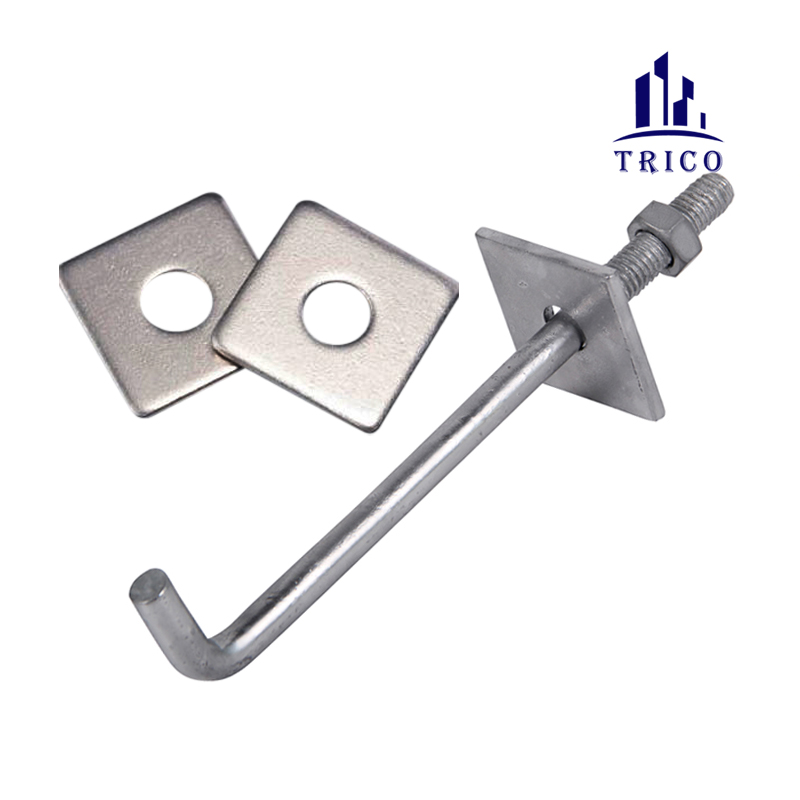When the mechanical components are installed on the concrete foundation, the J-shaped or L-shaped ends of the bolts are buried in the concrete.
The tensile capacity of the anchor bolt is the tensile capacity of the round steel itself. The size is equal to the cross-sectional area multiplied by the allowable stress value (Q235B: 140MPa, 16Mn or Q345: 170MPA), which is the allowable tensile bearing capacity during design.

Anchor bolts are generally made of Q235 steel, which is smooth round. Rebar (Q345) has high strength, and it is not as easy to make a nut thread as it is to make a round nut. For smooth round anchor bolts, the burial depth is generally 25 times its diameter, and then a 90-degree hook about 120mm long is made. If the diameter of the bolt is very large (such as 45mm) and the burial depth is too deep, you can weld a square plate to the end of the bolt, that is, just make a big head (but there are certain requirements). The burial depth and the hook are all to ensure the friction between the bolt and the foundation to prevent the bolt from being pulled out and damaged.
Types of anchor bolts
Anchor bolts can be divided into fixed anchor bolts, movable anchor bolts, expansion anchor bolts and adhesive anchor bolts. According to different shapes, they are divided into: L-shaped embedded bolts, 9-shaped embedded bolts, U-shaped embedded bolts, welded embedded bolts, and bottom plate embedded bolts.
Use
1. Fixed anchor bolts are also called short anchor bolts. They are poured together with the foundation and are used to fix equipment without strong vibration and impact.
2. Movable anchor bolts, also known as long anchor bolts, are detachable anchor bolts used to fix heavy mechanical equipment that suffers strong vibration and impact.
3. Expansion anchor bolts are often used to fix stationary simple equipment or auxiliary equipment. The installation of expansion anchor bolts should meet the following requirements: the distance from the center of the bolt to the edge of the foundation should not be less than 7 times the diameter of the expansion anchor bolts; the strength of the foundation for installing expansion anchor bolts should not be less than 10MPa; there should be no cracks in the drilled holes, and care should be taken to prevent The drill bit collides with the steel bars and buried pipes in the foundation; the drilling diameter and depth should match the expansion anchor bolts.
4. Bonding anchor bolts are a type of anchor bolts commonly used in recent years, and their methods and requirements are the same as expansion anchor bolts. However, when bonding, be sure to blow away any debris in the hole and keep it away from moisture.
Installation Method
1. One-time burying method: When pouring concrete, bury the anchor bolts. When high towers are controlled by overturning, the anchor bolts should be buried once.
2. Reserve hole method: put the equipment in place, clean the holes, put the anchor bolts into the holes, position the equipment and then pour it with non-shrink fine stone concrete that is one level higher than the original foundation, and tamp it tightly. . The distance from the center of the once-buried anchor bolt to the edge of the foundation should not be less than 2d (d is the diameter of the anchor bolt), and should not be less than 15mm (when d≤20 should not be less than 10mm), and should not be less than half the width of the anchor plate Add 50mm. When the above requirements cannot be met, appropriate measures should be taken to strengthen them. The diameter of structural anchor bolts should not be less than 20mm. When subjected to earthquake action, double nuts should be used for fixation, or other measures to effectively prevent loosening should be adopted, but the anchoring length of the anchor bolts should be 5d longer than the anchorage length without earthquake action.
Installation plan of anchor bolts. Dealing with loose anchor bolts in the foundation. When tightening the anchor bolts, the bolts may be pulled loose. At this time, the bolts should be adjusted to their original positions first, and sufficient foundation should be shoveled out around the bolts. , then weld two vertical and horizontal U-shaped steel bars to the bolts, and finally clean and grout the pit with water. After the concrete has solidified to the design strength, tighten the live anchor bolts. The method of handling the deviation of the live anchor bolts is roughly the same as that of the dead ground. The method for anchor bolts is the same, except that the anchor bolts can be pulled out and disposed of. If the bolt is too long, a section can be cut off on the machine tool and then threaded; if the bolt is too short, it can be stretched by hot forging; if the position does not match, it can be corrected by bending.
Application industries: Suitable for fixing various equipment, embedded parts of steel structure foundation, street lights, traffic signs, pumps, boiler installation, embedded fixing of heavy equipment, etc.


Comments
Please Join Us to post.
0